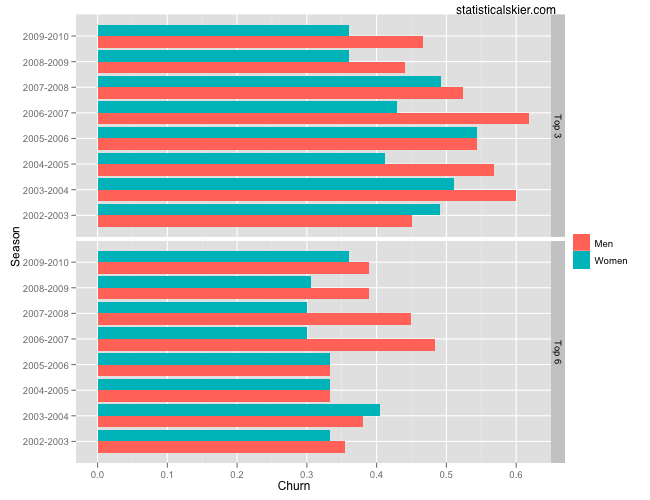I was listening to FasterSkier’s podcast the other day and was a bit startled to here one of the participants mention me by name![1. By the way, Christopher, it’s pronounced JOR-an; like “Jordan” but with no “d”. Â My parents gave me the Scandinavian name, but not the Scandinavian pronunciation. Â And shame on you, Colin, for not correcting him. Â You know how to say my name!]
The topic was whether we tend to see the same few skiers at the top in women’s sprint races more than in men’s races. Â In other words, are we more likely to see “random” skiers make the A-final or even the top three in a men’s sprint race? Â I actually posted something related to this a while back that was more geared towards the question of competitiveness. Â I did some fancy math and concocted something to measure this idea that I called “churn”. Â Basically it measures the degree to which we see the same group of people in the top 3, or top 5 or whichever group we’d like to look at. Â But the graph in that post isn’t very useful for comparing men and women directly.
Let’s start really simple. Â For sprinting, I’d say we’re most interested in the top 3 (podium) and the top 6 (the A-final). Â Last season we saw 15 different women on the podium versus 19 for the men. Â There were 32 different women women reached the A-final (top 6) at least once, versus 34 for the men. Â On a basic level, this supports the notion that there’s more “churn” in men’s sprinting, while we’re more likely to see the same women in the top 3 or 6 in sprint races.
But the differences are pretty small, of course. Â So keep in mind that often we’re talking about an extra 3-4 skiers rotating into the podium spots or the A-final.
I’m not going to rehash my derivation of how I defined churn. Â You can go reread the above link if you’d like. Â Let’s just say that the result is a number between 0 and 1. Â A churn of 0 would mean that the exact same set of skiers is on the podium (in a possibly different oder) every single race. Â A churn of 1 would mean that every race we get a totally new set of skiers on the podium. Â Here’s two bar charts comparing men and women for several seasons:
 Generally speaking, the men experience more “churn”, both on the podium and in the top six. Â But again, keep in mind that these differences are often being driven by the addition of as few as 3-5 skiers reaching the podium or top six. Â On the one hand, that’s not a lot of skiers in an absolute sense. Â On the other hand, compared to the number of skiers we’re talking about (1-2 dozen usually) that’s a fairly significant percentage of the total. Â Whether that’s a meaningful difference of not, I’ll leave up to you.
Generally speaking, the men experience more “churn”, both on the podium and in the top six. Â But again, keep in mind that these differences are often being driven by the addition of as few as 3-5 skiers reaching the podium or top six. Â On the one hand, that’s not a lot of skiers in an absolute sense. Â On the other hand, compared to the number of skiers we’re talking about (1-2 dozen usually) that’s a fairly significant percentage of the total. Â Whether that’s a meaningful difference of not, I’ll leave up to you.
[ad#AdSenseBanner]
{ 2 } Comments